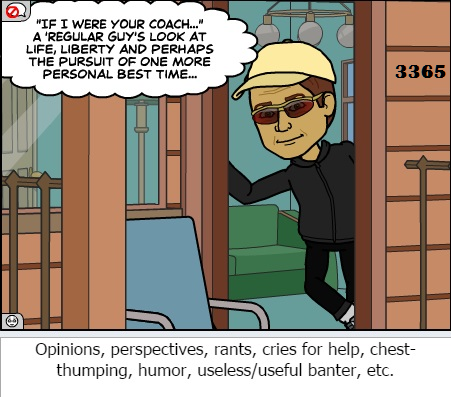Define "that." "That" is short for 'run a distance race in an undertrained state.'
Even the definition of "undertrained" can be kind of nebulous and squishy. To differentiate between the two most common forms, there's "undertrained," as in "haven't done as many long runs, or speed workouts as I would have preferred." That's a more-tolerable and more-desirable state. There have been some of those worried chats before, where I've told one or two of my own (panicky) athletes their one-toke-short-of-the-line state wasn't such a bad thing. That form of undertrained is much better than being overtrained (under-recovered).
Then there's the other "undertrained" state. That's the one that's most simply defined as "insufficient training volume for the target distance," or the "just lay it out there and pray to whatever gods may be that muscle memory saves the day" state.
In some quarters it's also known, politely, as "extracting a race effort from a portion of the runner's nether region."
When athletes I've worked with in the past have told me "I'm thinking about going to do the (insert event name here), but I haven't trained for it..." in the overwhelming majority of cases the next sound they hear from my mouth sounds like a cross between screaming and...
Even I asked myself a couple of months ago that very question, "Bones."
Suzanne had the temerity to suggest last week that I hang back in the same corral with her and Teri, amble along and watch the sights at a pace which would have been about 65 percent of my planned effort. Ah, but I remembered all-too-well trying to hold back and run with Suzanne...at 50-to-60 percent of my ability...about four years ago. Frustrating for her. Painful for me.
Suzanne had the temerity to suggest last week that I hang back in the same corral with her and Teri, amble along and watch the sights at a pace which would have been about 65 percent of my planned effort. Ah, but I remembered all-too-well trying to hold back and run with Suzanne...at 50-to-60 percent of my ability...about four years ago. Frustrating for her. Painful for me.
So, it was time to pull out the proverbial "plan B" for the morning. I had already penciled in the need to do 40-minute workouts (running, spinning, rowing, or lifting) during the week. Why not use this time as a workout in the presence of 20,000 friends...most of whom still owed me at least one beer? The first 40 minutes would be a great time for a moderate-pace run, after which the crowd would probably thin out enough to let me get about 40 minutes of "speed work" in. After that I figured the next 10-to-30 minutes would serve as that "extraction from the nether region" time. If I felt great I'd drop the hammer, and if not I'd smile and let the crowd pull me along to the finish.
The first 40 minutes went almost like a charm. Only a few seconds off the pace I would have loved to have completed for the entire race. The second 40 minutes went almost according to plan. Reality began to set in at about 1:15, aboutt the time when I normally finish my Sunday morning runs. Trouble was I had somewhere between four and five miles left. With two miles to go I could feel the first twinges in my left calf, which really slowed the flow of progress. A little adjustment, a little self-talk, and a little music had me back on track. I finished in 1:56, and suspect if I had run steady for the second 40-minute piece my finish would have been around the same as my previous half-marathon...eight months ago.
The lesson I hope you take away from this is: There's a range of training volume - distance, intensity, time - which is perfect for each race distance. A runner doing 60 miles a week can get away with running a 5,000-meter road race, and might do it with a 2-to-3 mile warm-up/cool-down. On the other hand, a 20-mile-a-week guy (or gal) who jumps into a half-marathon is asking for trouble...especially if it's their first one. A more-experienced runner might get away with being a little under-prepared, but they're more likely...transiently...out of their Vulcan mind.

